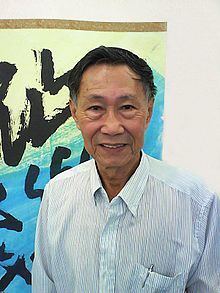Nationality Singapore | Role Artist Name Ho Ying | |
 | ||
Movement Abstract expressionism, Chinese ink painting Books Re-connecting: Selected Writings on Singapore Art and Art Criticism | ||
Tribute sg ho ho ying
Ho Ho Ying (Chinese: 何和应; pinyin: Hé Héyīng) is a Singaporean abstract artist known for his avant-garde Chinese calligraphy and his Abstract Expressionistic works of art unique to Asian ideology. He is also an accomplished author under his reputed moniker Zǐ Mù (子木), and an art critic for the Singapore visual arts community.

Ho was born the eldest of five children, in Hainan. When he was born, his father had left the family to come to Kuala to work as a cook for a British family. Much of his childhood years was spent with his mother, a housewife on the island, and at the outbreak of Second Sino-Japanese War Ho and his mother had escaped the invaders' capture and reunite with the elder Ho in Kuala Lumpur in 1941. He was 5 when he arrived in the city, only to find that the city had fallen to the Japanese a year later. Life was harsh, but the studious boy continued his education with the Chung Hwa Confucian Primary School (尊孔小学). In school, he learnt basic Chinese calligraphy and art lessons in class, copying drawings made by his teacher on the blackboard. In his free time, he would immerse himself at comic book stalls along Petaling Street (Chinese: 茨厂街; pinyin: cíchǎng jiē), poring through Chinese wuxia comics (Chinese: 连环书; pinyin: liánhuán shū) and copying the comic book characters back home. He continued school at Chung Hwa Confucian High School (尊孔中学) until in 1951, when his family relocated to Singapore. He attended the Chinese High School, and developed strong interest in art under the influence of school teachers Liu Kang and Chen Wen Hsi. As he was a poor and could not afford art materials, Chen would often offer him money to buy the art materials. Ho's confidence in his art grew as he was proficient with Chinese calligraphy and often won awards in school. When he was 18 years old, his mother died of cervical cancer shortly after giving birth to his youngest sister. Without their mother, Ho had to take on the responsibility of taking care of his siblings and a 4-and-half months old infant sister, while his father was away working in a British household. As his father earned little as a cook, Ho often had to seek credit for food and provisions from shop owners.
In 1962 Ho graduated from Nanyang University with a Bachelor (Arts) in Chinese Language and Literature. In 1963, Ho along with seven other artists Wee Beng Chong, Tong Siang Eng, Tay Chee Toh, Tan Yee Hong, Johnda Goh and Ng Yat Chuang frequently gathered together to discuss the development of the country’s fine art, and came to develop a singular thought that modern art for Singapore should be explored with loft and zeal. And so in October that year they founded the Modern Art Society, and launched their First Modern Art Exhibition at the National Library. In 1975, Ho was presented with an award the Malay arts group APAD (Angkatan Pelukis Aneka Daya) for his contribution in promoting art among different racial art groups in Singapore and uniting various ethnic art organisations.
Ho's art evolved through his years, from Chinese calligraphy aesthetics ingrained in him when he was a schoolboy, to Western art influences by Impressionism and by mother-and-child paintings by Fauvist masters. In the 1950 - 60s, Ho found his true calling in his artistic expressions, when he laid eyes on Nature-themed semi-abstract paintings and Surrealism for the first time. He was especially enthralled by the free movements of American artists like Jackson Pollock and other artists existing at the time of his youth. This new spirited aesthetic resonated with the Taoist saying, Let thinking be like a bird in the sky - a saying that lived close to his art throughout his life. It inspired him to live freely in his canvas, escaping from the world of rigidity and systemic restrictions that humans live in. It enabled him to break boundaries in his expression on, and beyond the canvas. Together with his penchant for blue, red and black colours on his palette, his paintings show a unique artistic identity that is signature to Ho Ho Ying.
